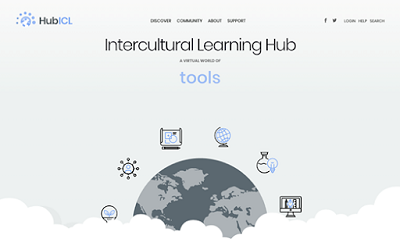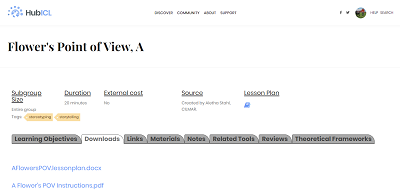|
In this article, I introduce you in a playful way to the Intercultural Learning
Hub (HubICL), a science
gateway for interculturalists to network, find and share
resources, and publish scholarship. After learning the HubICL’s
backstory, getting a guided tour and a special gift, and hearing about
plans for the future, I hope you will find it useful (and fun) to
collaborate!
Dr. Acheson-Clair: HubICL, I’d
like to introduce you to some of the best folks around, the members of
TESOL’s Intercultural Communication Interest Section (ICIS).

Caption: HubICL homepage
TESOL ICIS, meet the HubICL—well, officially the Intercultural
Learning Hub, but people only ever say that once before looking for a
way to shorten it. Since the URL is hubicl.org, most end up at “the
HubICL,” pronounced /hʌ:bɪkl/, or even just the Hub. I think you will
get along famously, so I’ll get out of the way and let the HubICL tell
you their story…
HubICL, tell us where it all started!
HubICL: I am built on the
shoulders of giants, theoretical pioneers such as Janet Bennett who gave
us the gift of stage-based pedagogy—tailoring curriculum to learners’
stages of intercultural development—as well as early internet
innovators, like TESOL’s beloved Dave Sperling of the ESL Café, who have been
building collaborative spaces to share resources online since the
internet first became a thing.
I began as a dream to create a one-stop shop for
interculturalists. I grew out of a spreadsheet that mapped experiential
intercultural activities to learning outcomes and developmental stages. I
found a home in the “science gateway” model because it was important to
my family that I be robustly grounded in scholarship but profoundly
useful to practitioners. I am and will always be accessible at no
charge, although I do require a free membership to keep out spammers and
hackers.
I was initially developed by the team of intercultural learning
specialists at Purdue
University’s Center for Intercultural Learning, Mentorship, Assessment
and Research (CILMAR), and this team still supports my
maintenance and growth. But, like all science gateways, I will only
survive with an active membership that continuously contributes new
content. I am like language in that way: “Use it or lose it!”
May I show you around? Different folks appreciate various nooks and crannies…

Caption: Community tab & dropdown options
One of my favorite things to do is help friends network and
collaborate. For example, if you want to work with others on a project,
feel free to form a group, open a discussion forum, share project files,
and more in the Community
area.
Or, maybe you’ve done scholarly work that needs to escape the
ivory tower and see the light of day. Papers, presentations, posters,
videos—innovations of all kinds are welcome in the HubICL Research Repository
(under “Discover”).
Next on the tour is Collections (also
under “Discover”). Not that kind of
collections—there are no debts here, only a space that may seem familiar
if you have been on Pinterest or another social media platform that
allow you to “pin” or collect things. Have favorites in the HubICL or
anywhere on the WWW that you don’t want to lose? Link to or upload them
into a themed collection. Keep your favorites private or share them with
the world. You can even collect other people’s collections if you like
their taste better than your own.
But the spot I think may become the TESOL ICIS hangout is
the Digital Toolbox (under
the Discover top menu). For sure, those of you who are classroom
teachers will want to bookmark it or save the link for easy reference.
Here you’ll find over 600 experiential activities, assessment
instruments, media and texts, debriefing and reflection tools, and
courses/training programs that support intercultural learning. But wait,
it gets better! They aren’t just listed; they are indexed and curated.
You can search them by AAC&U
VALUE rubric learning outcomes; by orientation on theIntercultural
Development Continuum; and by contextual considerations, such
as how long they take, whether they require movement, and whether they
cost money. Many have links or downloads for open-access (cost-free)
materials, such as handouts or lesson plans. No, really, don’t applaud.
You are embarrassing me.

Caption: Digital toolbox option under Discover tab
Before we part ways for now, I’d like to give you a little
something to seal our new friendship: Just a taste of what the Digital
Toolbox has to offer. If you couldn’t wait and have already registered for a HubICL
account, you can follow along as I unwrap this gift for
you.
If you were to click on the “Discover” top menu and choose
“Tags,” you could search for a term such as icebreaker.
Forty-three tools come up in that search. We think of these tools as
“icebreakers that teach”—that is, activities that serve the dual
purposes of simultaneously supporting intercultural learning and
encouraging your students to get to know/grow more comfortable with each
other. A couple I would especially recommend for the U.S. TESOL
setting, where you may have a room full of culturally and linguistically
diverse learners, are the Name
Game and Voices from the
Past. Both of these activities capitalize on the diversity in
the room to showcase the cultural values underlying naming practices
and traditions in the first case and common sayings in the second. They
both are easy enough for novice language learners but still interesting
for those at an advanced level. They usually don’t take more than 20–30
minutes (depending on group size), and the materials for them don’t cost
money.
For those of you in international TEFL settings with classrooms
that are more homogenous, I’ve got something for you, too. From the
main Digital
Toolbox page (remember, under the Discover top menu), try
searching a) for an Experiential Tool b) with no external cost c) that
is not kinesthetic and d) focuses on empathy. One of the search returns
should be A Flower’s
Point of View. We’ve had great success with this
CILMAR-original tool for achieving the following learning outcomes with
culturally homogenous groups: 1) exercising imaginative empathy and 2)
identifying both the possibilities and limits of empathy. It is one of
my favorites because it combines individual reflective creative play (in
writing mode) with peer-learning through dialogue (in speaking mode).
You can find these activities and more options that might appeal to
TESOL ICIS members in a collection made just for you: “Intercultural
Activities for TESOL/TEFL.”

What’s that? Oh, you are very welcome. [shy smile] I hope we meet again soon.
Dr. Acheson-Clair: Hi. Kris here, again.
Thank you for taking the time to read about the HubICL. Looking
back over their self-introduction above, I am pleased as punch to see
the Hub taking on a life of their own.
Before you go, I’d like to share a bit about what is on the
horizon for the HubICL. As we continue to build content in existing
areas of the site, behind the scenes a new wing of the Hub is also under
construction. You can imagine it as a professional development (PD)
area. Like the rest of the Hub, the new PD zone is not meant for
end-users (learners) but rather for those of us who mentor the
development of others (instructors); this space will host
train-the-trainer resources, such as courses, seminars, certificate
programs, graduate degrees, workshops, proprietary assessment trainings,
coaching providers, and more. Essentially, it will be a place for
interculturalists like you to find and track (with badges for completed
modules) PD opportunities. For PD providers, likewise, it will provide a
way to market offerings and at times even deliver content. It should be
online in 2021, but meanwhile we welcome any reactions and suggestions
that may help us better construct this new addition to the HubICL. You
can email cilmar@purdue.edu with your
thoughts.
I hope you enjoyed getting to know the HubICL. I see so much
promise in your budding relationship, so I will keep my fingers crossed
that you will join the 2,000+ existing members in using, building, and
spreading the news about your new friend.
Cheers!
Kris
Dr. Kris Acheson-Clair, former faculty in applied
linguistics at Georgia State University and Fulbright scholar to
Honduras, currently directs Purdue University’s Center for Intercultural
Learning, Mentorship, Assessment and Research. |

